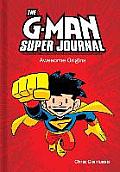The G-Man Retcon
Chris Giarrusso created his comic G-Man in bits and pieces: short stories, backup features, comic strips, half-parodies of other superhero sagas.
As the Image Comics webpage for the first volume says, G-Man: Learning to Fly “Collects the origin of G-Man and Great Man, the G-Man Christmas Story, Mean Brother/Idiot Brother adventures, and a complete collection of the original G-Man comic strips that started it all.”
Because that book is a grab bag, its pieces come in different sizes and lengths. Some were obviously designed for different sizes, and they have different storytelling rhythms. It’s still a fun read. We see Mikey and his big brother Dave gaining their powers from the family’s magic cape. Several of their (male) friends already have superpowers, with no explanation. It’s just a fact of life at their school.
Two G-Man miniseries/graphic novels followed, each with a wider focus showing more of the brothers’ universe. There’s more explanation of the magic cape in Cape Crisis, the best of the volumes. We meet the Color Guardians, female classmates who are one unfathomable mass to the boys, and the Suntroopers and Thunderfriends teams of grown-up heroes.
The latest G-Man installment comes from another publisher and takes another form: an illustrated middle-grade novel written as a daily journal, like Jeff Kinney’s Diary of a Wimpy Kid and Rachel Renee Russell’s Dork Diaries. Most of the pictures, supposedly by young Mikey, are in a simpler, line-art style which Giarrusso is also using for a weekly online comic strip. There are occasional full-color pin-up pages as well, in the guise of photos taped into the journal.
In addition, The G-Man Super Journal: Awesome Origins is a prequel, going back not only to before Mikey gained his powers but before all his friends had theirs. It folds in characters who first appeared in the graphic novels, such as the Color Guardians, Cool Wraps, and that annoying kid Tony. And it offers explanations for how all the kids got their powers. Actually, several explanations for each: alien birth, divine descent, freak accidents, top-secret website in Japan, and so on. As a result, G-Man: Super Journal is now the most complete introduction to the G brothers’ saga.
Whereas Learning to Fly’s big scenes are mostly at home and Cape Crisis on the playground, Awesome Origins is driven by events at school: Mikey’s struggle with a teacher who doesn’t like superheroes, tests to join the Suntroopers, and most especially that annoying kid Tony. The illustrations have a deadpan sarcasm that (along with the superpowers, of course) distinguishes this series from its diaristic forebears.
I still prefer the G-Man comics, but a mostly-new G-Man story in illustrated prose form is still a lot of fun. And its publisher’s wider distribution might bring new readers to all the volumes.
As the Image Comics webpage for the first volume says, G-Man: Learning to Fly “Collects the origin of G-Man and Great Man, the G-Man Christmas Story, Mean Brother/Idiot Brother adventures, and a complete collection of the original G-Man comic strips that started it all.”
Because that book is a grab bag, its pieces come in different sizes and lengths. Some were obviously designed for different sizes, and they have different storytelling rhythms. It’s still a fun read. We see Mikey and his big brother Dave gaining their powers from the family’s magic cape. Several of their (male) friends already have superpowers, with no explanation. It’s just a fact of life at their school.
Two G-Man miniseries/graphic novels followed, each with a wider focus showing more of the brothers’ universe. There’s more explanation of the magic cape in Cape Crisis, the best of the volumes. We meet the Color Guardians, female classmates who are one unfathomable mass to the boys, and the Suntroopers and Thunderfriends teams of grown-up heroes.
The latest G-Man installment comes from another publisher and takes another form: an illustrated middle-grade novel written as a daily journal, like Jeff Kinney’s Diary of a Wimpy Kid and Rachel Renee Russell’s Dork Diaries. Most of the pictures, supposedly by young Mikey, are in a simpler, line-art style which Giarrusso is also using for a weekly online comic strip. There are occasional full-color pin-up pages as well, in the guise of photos taped into the journal.
In addition, The G-Man Super Journal: Awesome Origins is a prequel, going back not only to before Mikey gained his powers but before all his friends had theirs. It folds in characters who first appeared in the graphic novels, such as the Color Guardians, Cool Wraps, and that annoying kid Tony. And it offers explanations for how all the kids got their powers. Actually, several explanations for each: alien birth, divine descent, freak accidents, top-secret website in Japan, and so on. As a result, G-Man: Super Journal is now the most complete introduction to the G brothers’ saga.
Whereas Learning to Fly’s big scenes are mostly at home and Cape Crisis on the playground, Awesome Origins is driven by events at school: Mikey’s struggle with a teacher who doesn’t like superheroes, tests to join the Suntroopers, and most especially that annoying kid Tony. The illustrations have a deadpan sarcasm that (along with the superpowers, of course) distinguishes this series from its diaristic forebears.
I still prefer the G-Man comics, but a mostly-new G-Man story in illustrated prose form is still a lot of fun. And its publisher’s wider distribution might bring new readers to all the volumes.



No comments:
Post a Comment